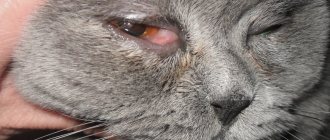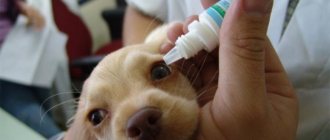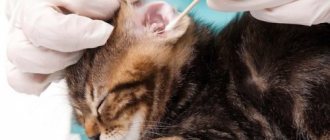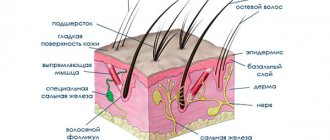A fairly common pathology in domestic cats, characterized by one or both testes not descending into the scrotum, is called cryptorchidism. A cryptorchid cat is not considered sick to the fullest extent of the word, but the phenomenon negatively affects the animal’s ability to produce offspring, and can also cause other ailments.
Today we will talk about how to identify cryptorchidism in a cat, whether castration of cryptorchid cats is mandatory, how the pathology is operated on, and we will discuss post-operative care for the animal.
Cryptorchid cat: surgery
Cryptorchidism in cats: general information
Most often, unilateral cryptorchidism occurs in cats - when one testicle is not descended into the scrotum. Among all animals suffering from this pathology, only two percent have bilateral cryptorchidism, that is, undescended two testes at once. Accordingly, bilateral cryptorzyme is an extremely rare phenomenon. Undescended testicles remain in the peritoneal cavity or “get stuck” in the inguinal canal.
Table 1. Variations in the occurrence of pathology - cryptorchidism
| Name | Description |
| Abdominal | The testis is located in the peritoneal cavity, inaccessible to palpation, and can only be detected through ultrasound examination. In this case, the testis in abdominal cryptorchidism is often underdeveloped, small in size, and may be hidden by intestinal loops or other organs. |
| Inguinal | An undescended testicle is located in the groin area, behind the fat layer, it is quite easy to feel, and in large adult cats with short hair, such an undescended testicle is visible to the naked eye - it looks like an oval tubercle above the scrotum. Cat owners are often frightened, mistaking this variant of cryptorchidism for a neoplasm. |
| False or pseudocryptorchidism | This variant of cryptorchidism, in fact, is not a pathology and has a second name - “wandering testis”. It is characterized by the retraction of a normally developed animal when the animal is afraid or the surrounding temperature is excessively low. |
| Secondary | A complication of false cryptorchidism, when initially both testes are developed normally and descended into the scrotum, but once the testicle is pulled inside, it no longer comes back - due to adhesions inside the peritoneal tissue or the fat layer in the groin area. |
False or wandering cryptorchidism
What it is?
Cryptorchidism is a disease accompanied by a violation of the anatomical structure in males, in which the testes remain in the abdominal cavity or the lumen of the inguinal canal. In healthy cats, the testes reach the scrotum closer to 8-10 weeks, which occurs under the influence of hormones.
Cryptorchidism is diagnosed in approximately 3% of cats. The most common form of the disease is one-sided, but in rare cases anarchism is observed (when the scrotum is completely empty). Since cryptorchidism only partially affects the body’s ability to produce sex hormones, cats with this pathology remain attracted to females. But due to the fact that the quality of sperm in cryptorchids is significantly lower, such cats rarely manage to have offspring.
Such cats rarely become fathers
Important! Most veterinarians insist on mandatory sterilization of cryptorchid cats, since the subsequent disease can negatively affect the health of the pet.
Causes of cryptorchidism in cats
This deviation does not have an exact and single cause, since the pathology usually has several provoking factors. First of all, these include deviations of a genetic nature, as well as features inherited from a mother or male cat: an excessively narrow inguinal canal, a predisposition to adhesions, a short testicular cord.
Also, a kitten can “get sick” with cryptorchidism due to an infection suffered by the pregnant mother or the kitten itself at an early age, as well as due to postnatal trauma. Pathology can also be caused by hormonal imbalances, as well as forced use of potent drugs by a pregnant cat or newborn kitten.
Unilateral cryptorchidism
Most cases of cryptorchidism in cats are associated with a lack of hormones. They are responsible for contracting a special ligament that pulls the testes from the peritoneal cavity into the scrotum. If there are not enough hormones, the movement of the testicles either does not begin at all or stops midway.
Another common cause of pathology is problems with the nervous and muscular apparatus of the groin area in general or the scrotum in particular. Such problems are considered to be a narrowed inguinal canal, folds blocking the “entrance” to the scrotum or an underdeveloped spermatic cord.
Undescended both testes
Strange as it may seem, the factor that provokes cryptorchidism in cats can be the negligence of the animal owner. Wanting to get offspring from a cat, the owner breeds it without passing the simplest tests on the pet, or without requiring such actions from the cat’s owner. As a result, the animals can infect each other with chlamydia, a virus or infection that will then affect the development of the kittens.
And finally, one of the rare provoking factors is overdeveloped and large testes that physically cannot enter the scrotum area; even the groin canals are of normal size.
Testicles that are too large may simply not fit into the scrotum
Cryptorchidism: clinical picture of pathology
The main symptom is, of course, a visual or manual defect. Cryptorchidism can be noticeable with the naked eye, as well as upon palpation. However, not every animal will allow you to palpate the intimate area, and not every owner is interested in probing the cat’s scrotum. In this case, nonspecific, non-characteristic signs become:
- Lack of pregnancy in a cat, despite multiple matings (the symptom may not appear in half of the cryptorchid cats - they continue to be able to “make” offspring).
- Cryptorchid cats, unlike full-fledged cats, are more likely to try to harass cats, even when they are not in heat. In turn, during a period favorable for mating, cats are more aggressive towards cryptorchids than towards cats with normal development.
- The scrotum does not look tight and full, but rather flabby and wrinkled.
- When urinating, the animal may shudder; cryptorchid cats often go “small” to the toilet, like dogs - with one hind paw raised.
Cryptorchid cats have peculiarities when urinating
- Concomitant diseases of the genitourinary system. Sometimes undescended testes are accompanied by testicular neoplasms.
- Loss of fur. Due to a lack of appropriate hormones, cryptorchid cats may begin to go bald. Darkening of the skin in the genital area is also observed - for the same reason.
- Tendency to lose masculinity. Cryptorchids, as they grow older, lose their brutal “masculine” features and become more refined, the skeleton becomes thinner, and the appearance of the cat becomes similar to the appearance of a graceful cat.
Cryptorchidism makes a cat look like a cat
But a rare symptom in cryptorchids is pain. Pathology produces painful symptoms only when the testes remaining in the peritoneal cavity already experience negative changes, for example, they become inflamed or develop into a neoplasm.
In severe cryptorchidism, the cat exhibits a painful reaction when the owner or veterinarian palpates the peritoneum. This is due to the twisting of the testicle on the axis, which entails pinching of the nerve canals, vessels and ducts that remove the seed. This process causes severe inflammation; in extreme cases, necrotic phenomena and even organ decomposition are possible.
The cat’s increased attention to the scrotum area is a reason to check the “set” of testes
Benefits of the procedure
Owners are not always ready to neuter their pets. Men may be especially hostile to this procedure. Despite outbursts of feelings of solidarity and concern for the safety of the cat’s personality, castration is still worth carrying out if the animal is not intended for breeding. The operation relieves the male of suffering caused by unrealized sexual instinct. The owner gets a calmer pet and does not have to worry about regular screams and smelly marks in the apartment (house).
Removing the testes or stopping their work does not always radically change the behavior of the animal. It is believed that a neutered cat turns into a lazy carcass, focused only on food. In reality, the male often retains his previous character traits such as playfulness and activity. Aggression provoked by the production of male sex hormones is significantly reduced. Castration, like sterilization of females, potentially prolongs the life of a pet, reducing the risk of developing diseases of the genitourinary system. The procedure reduces the cat's activity, so that he is less likely to want to go outside. That is, the likelihood of a male dying under the wheels of a car or in a fight for a partner decreases.
How to detect cryptorchidism in kittens and cats?
When purchasing a small kitten, the future owner is unlikely to be able to detect cryptorchidism in it. Firstly, the testes are still too small, and secondly, normally they can enter the scrotum for up to three to five months. If your pet has reached the age of six months, and one or two testicles are still not palpable, you need to visit a veterinarian.
Surgery is mandatory for a cryptorchid cat
Important point! Unscrupulous breeders can hide from the owner the fact that the kitten has a pathology. At the same time, if cryptorchidism is discovered in a cat, not only the owners who purchased a purebred animal with the initial prospect of breeding will suffer, but also the owners of the outbred cat, since both will need surgery.
If the testis, which has not descended into the scrotum, is not accessible for palpation, an ultrasound examination should be performed in order to draw up a surgical plan.
How to prepare a cat for an ultrasound?
How to identify the problem: main signs
The owner may not find out about the cat’s illness, since he does not experience problems during mating.
Owners are not always able to immediately determine that a cat is cryptorchid, especially if the animal is still very small. It is possible to understand that a pet’s testicles are not descended after 6 months of birth. In most cases, the disease is detected visually or by palpation. Often, with an advanced disease, an animal has a hard testicle or the owners note that it is swollen and an unpleasant-smelling discharge appears. But sometimes difficulties arise in identifying cryptorchidism, since the cat is sexually active and the symptoms of the disease do not affect mating in any way. If the disease is bilateral, then spermatogenesis is absent.
Treatment for a cryptorchid cat
Cryptorchidism itself is not a fatal disease, and in some cases it is not dangerous to the health of the cat. But this does not mean that the owner should ignore the problem. There are two options for treating a cryptorchid cat: with drug therapy and surgery.
Cryptorchidism and hormone therapy
To treat cryptorchidism, in some cases, hormonal drugs are used, which are designed to compensate for the lack of the cat’s own hormones. This treatment option is used only after completing a full course of tests and studies, and with a confirmed lack of the hormone testosterone. That is, in the case when its deficiency is really the root cause of the pathology.
The use of hormone therapy in kittens under one year of age is prohibited, since drugs that include a serious dose of testosterone negatively affect the hypothalamus, which will certainly affect the proper growth of bones and ligaments in the skeleton of a young animal.
Hormone therapy is only permissible for mature adult cats.
Note that drug treatment is often ineffective at all, or has a temporary positive effect. As soon as artificial testosterone is no longer administered to the animal, the pathology reasserts itself.
In addition, hormone therapy requires expensive tests, and the price of the drugs themselves is quite high. Veterinarians argue that there is no particular point in trying to treat a cat in this way - anyway, the animal should not be allowed to be bred so that it does not pass on the inferiority gene to its offspring.
Even cats with cured cryptorchidism are not allowed for breeding
Cryptorchid sterilization
According to veterinary experts, the most effective and radical way to solve a problem such as cryptorchidism is to sterilize the animal. We are talking specifically about sterilization, not castration, since cryptorchids require a full-fledged strip operation.
The intervention of a veterinary surgeon will not only ensure complete suppression of the animal’s desire to continue its breeding, but will also not allow the undescended testis to degenerate into a malignant tumor. It is this “side effect” that is the most terrible for a cryptorchid cat.
The process of sterilization of a cat with cryptorchidism
The ideal age to perform surgery on a cat is seven to eight months, but later surgical intervention is possible, up to eight to nine years. Before performing abdominal surgery, you need to consult with a specialist, take biochemistry and a general blood test with the animal, and also perform an ECG procedure in order to rule out cardiac ailments of the cat that could negatively manifest themselves during the administration of anesthesia or the operation itself.
As we have already mentioned, sterilization of a cat with pathology is a full-fledged operation, during which the surgeon enters the abdominal cavity of the animal. The operation takes place under full anesthesia and lasts approximately one and a half hours. Operative access will depend on which variation cryptorchidism belongs to.
Before surgery on an animal, you need to undergo a short medical examination.
Surgery for inguinal cryptorchidism
The animal, which has passed the tests, is put under anesthesia. The doctor will then use an electric razor to shave the hair around the incision area. The skin and adipose tissue are cut with a scalpel, the undescended testis is removed, and the testicular cord is cauterized with an electrical device - a coagulator. Stitches are then applied.
To protect the operated area from the cat’s rough tongue (during healing, the stitches itch and the cat will try to lick them), you need to put a special plastic collar on the cat. The pet will wear this collar until the suture material is removed - usually this happens within ten days after the operation.
The cat must be wearing a protective collar at all times.
It is also prohibited for a cat to lick a seam because a pet can easily introduce bacteria and dirt into a fresh wound along with saliva. Sutures need to be treated daily; Chlorhexidine is good for this purpose, but the doctor can independently smear the incision site with a long-acting antiseptic.
Surgery for abdominal cryptorchidism
This operation almost completely copies sterilization in cats. The animal is put under anesthesia, the belly is shaved, and then the belly is incised along the “linea alba,” finding the vas deferens. It is located next to the bladder, and the incision will be in this area. One or two testicles remaining in the peritoneum are pulled out and removed, after which suture material is applied.
Cat in anesthesia
Just like after surgery for inguinal cryptorchidism, the cat will need to purchase a protective collar, which he will wear until the stitches are removed.
Video - Operation for a cryptorchid cat
Diagnostics
Castration of dogs: at what age and is it necessary?
The veterinarian will be able to make a correct diagnosis and will figure out what examination methods are necessary for each specific animal in a particular case.
So, if the testis can be palpated, then, most likely, they will limit themselves exclusively to an external examination.
Ultrasound for a cat
Then, when a situation of development of abdominal cryptorchidism occurs, they resort to the method of ultrasound examination.
In order to conduct an ultrasound, no thorough preliminary preparation of the animal is required. The only thing that can serve as a minor hindrance is the obesity of your pet. Gases can also change the picture. That is why it is recommended not to feed the animal 6 hours before the procedure.
Rehabilitation after surgery
When taking an animal home after surgery, the owner should be aware of some rules that will allow rehabilitation to be carried out quickly and with minimal discomfort for the cat.
Firstly, you need to prepare in advance the place where the cat will be for the first hours after the operation. The animal is protected from drafts and excessively hot radiators. Fine. If you manage to restrict your pet’s movements using a carrier or cage, the cat will feel insecure when recovering from anesthesia and may get injured.
During the first hours after recovery from anesthesia, the cat should be monitored or placed in a cage.
You need to carefully monitor your pet's condition, reporting any negative changes to your doctor. If the cat refuses to eat for the first day or two, it's not a big deal. If the animal continues to ignore food, behaves lethargically and is not interested in anything, this is a reason to urgently visit a doctor.
Another common side effect of abdominal surgery in cats is the absence of bowel movements. To help your pet, you can give him a teaspoon of Vaseline oil, which acts as a mild laxative. But, it is worth using it on the third or fourth day if the cat was still unable to defecate on its own.
The oil can be mixed with food or administered into the cat's mouth using a rubber bulb.
You must also carefully follow the individual recommendations of your veterinarian. The cat may be prescribed hemostatic drugs, anti-inflammatory or antibiotics, and vitamins.
Rules of care in the postoperative period
For the operation, general anesthesia is used, so after castration it is recommended to spend the first hour in the clinic. Thanks to this, specialists will be able to quickly help your pet if complications arise. If the cat's breathing and heartbeat do not cause concern, he can be taken home.
After anesthesia, the animal's heat exchange will be disrupted. In the cold season, he needs to be wrapped in diapers or a blanket; in hot weather, overheating should be avoided. It is better to transport your pet in a personal car or taxi. It is not recommended to travel using public transport, because... The cat is already stressed.
A new environment and a large number of people around can frighten him. If the pet has not recovered from anesthesia, you need to moisten its eyes: close and open the eyelids. Otherwise, the mucous membranes may dry out.
After returning home, you need to create a cozy corner for the cat. You can put pillows or cover the floor with soft bedding. Drafts should be avoided. The animal must be kept away from batteries. If additional heating is needed, you can wrap warm water bottles with towels and place them nearby.
It is advisable to stay close to your pet, because... his consciousness and coordination of movements will be impaired at first. The cat may react aggressively towards you. If this happens, move away but keep an eye on him.
You can give water to your cat only 2-3 hours after the operation, when the pet comes to its senses. Otherwise, he may experience nausea. Do not leave a bowl of water nearby, as the animal may choke. Food is given after 6-8 hours. Solid particles can injure the operated area, so products with a rough texture should be avoided.
Dry food should be soaked. In order not to aggravate stress, it is better to give your cat his usual food. The animal is switched to new food after 1-2 weeks.
The tray is left as close to the cat as possible so that in the first days after the operation he does not have to move much. Perhaps the pet will miss. There is no need to scold him for this. It is advisable to remove the filler from the tray for 5-7 days or install a mesh. Coarse fibers can injure the animal.
Since cryptorchids undergo a more complex operation and involve tissue of the groin or peritoneum, cats need to wear blankets. It is advisable to observe the animal before removing the sutures. Some pets remove their blankets or lick the fabric and injure the wound with their rough tongue.
This may lead to bleeding or infection. If your pet shows increased interest in the injured area, you can put an Elizabethan collar on it.











